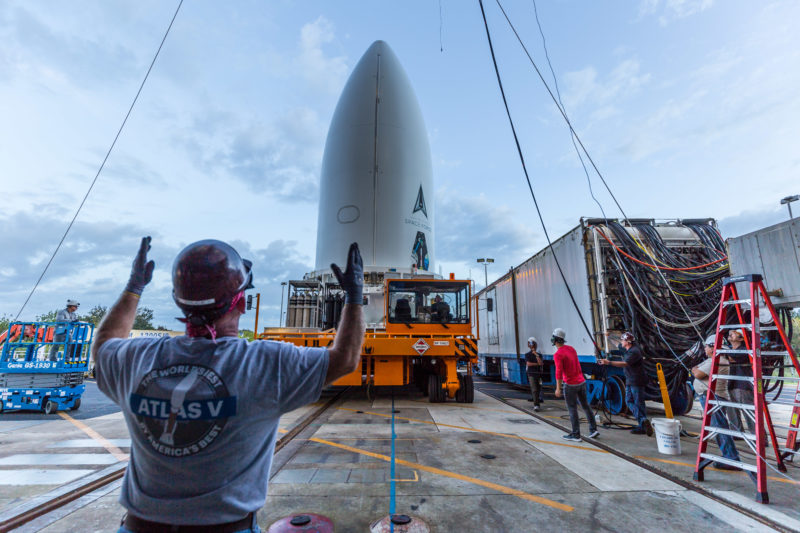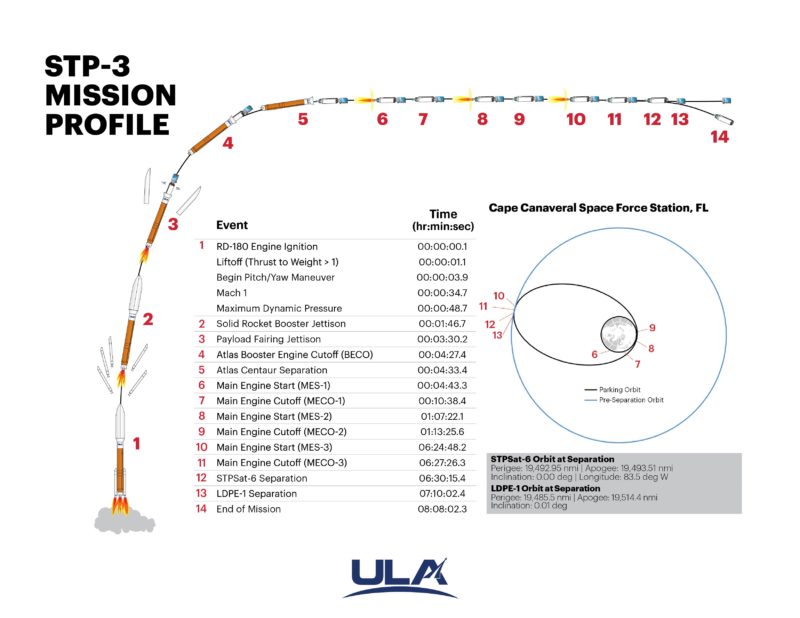
After multiple delays during 2021, the most powerful member of United Launch Alliance’s (ULA) Atlas V fleet—the “551”, equipped with a 17-foot-diameter (5-meter) payload fairing, five strap-on solid-fueled boosters and a single-engine Centaur upper stage—roared smoothly into the pre-dawn darkness at 5:19 a.m. EST Tuesday from storied Space Launch Complex (SLC)-41 at Cape Canaveral Space Force Station, Fla. Liftoff occurred 75 minutes into this morning’s two-hour “launch window”, having been delayed due to high-level winds.
Atop the rocket, nicknamed “The Bruiser” by ULA CEO Tory Bruno, was the Space Test Program (STP)-3 multi-disciplinary payload for the U.S. Space Force’s Space Systems Command, bound for direct insertion into geostationary orbit. Tonight’s launch marked this year’s fifth and final ULA mission, with high hopes that the Centennial, Colo.-headquartered organization may fly 12 Atlas V and Delta IV Heavy missions in 2022.
Contracts worth $191 million to launch STP-3 were awarded to ULA in June 2017, under the Air Force’s Phase 1A procurement strategy, with expectations that the mission might fly in the June-August 2019 timeframe. However, it has met with substantial delay. Its primary element is STPSat-6, whose design and integration contracts had previously been awarded to Orbital Sciences Corp. (now Northrop Grumman Corp.) in February 2017.

Based upon the A500 “bus”, STPSat-6 houses nine payloads on behalf of the Department of Defense, the National Nuclear Security Administration (NNSA) and NASA to “operationally demonstrate advanced communication capabilities, collect space weather data and support nuclear detonation detection in the Earth’s atmosphere or in near space”.
Leading this payload suite is the NNSA’s third Space and Atmospheric Burst Reporting System (SABRS-3), built by Los Alamos National Laboratory (LANL) in Los Alamos, N.M., which forms part of an ongoing effort to replace neutron, gamma-ray and particle detectors aboard outdated Defense Support Program (DSP) early-warning satellites. It will augment the optical, radio frequency, X-ray and particle sensors of the Global Burst Detector (GBD) aboard Global Positioning System (GPS) navigation and timing satellites.

Also aboard STPSat-6 is the Laser Communications Relay Demonstration (LCRD), provided by NASA’s Goddard Space Flight Center (GSFC) in Greenbelt, Md., which will furnish an end-to-end optical relay, capable of transmitting and receiving data from orbiting spacecraft to ground stations. Laser-based communications are expected to significantly benefit future missions by achieving lower sizes, masses and power needs, as well as increasing bandwidth by up to 100 times more than radio frequency systems.
“This evolution to more internet-like communications will reduce the amount of processing required before data can be sent to science and mission operations centers,” NASA previously reported. “LCRD will demonstrate the robust capabilities of optical communications.” It is expected that data at an approximate rate of 1.2 gigabits per second will be transmitted between LCRD and optical ground stations at Table Mountain, Calif., and Haleakala, Hawaii.

Seven additional experiments from the Department of Defense’s Space Experiments Review Board are also assigned to STPSat-6. One of them is thought to be the NNSA’s Space and Endo-Atmospheric NuDet Surveillance Experiment (SENSER), which seeks to reduce the developmental risks for future nuclear detection sensors by testing and evaluating critical technologies in the space environment, ahead of production and integration into next-generation systems.
The second element of the STP-3 payload is the Space Force’s Long Duration Propulsion ESPA (LDPE-1), also fabricated by Northrop Grumman. It represents the first in a series of experimental spacecraft to house small experiments and facilitate the deployment of miniaturized satellites.

Its design is based upon the ESPAStar bus, which utilizes a modified Evolved Expendable Launch Vehicle (EELV) Secondary Payload Adapter (ESPA) “ring” and supports a modular capability for hosting technology and operational payloads. The ESPAStar concept provides power, pointing, telemetry and command-and-control functionalities. LDPE-1 was delivered from Northrop Grumman’s facility in Gilbert, Ariz., to Cape Canaveral in December 2020 for launch preparations.
By this point, STP-3’s launch had moved to no earlier than 26 February 2021. However, in late January problems with STPSat-6 forced an additional delay in order “to enable ther customer to evaluate the launch readiness of the spacecraft”. Early in May, STPSat-6 was delivered from Northrop Grumman’s facility in Dulles, Va., to Astrotech Space Operations in Titusville, Fla.

At the same time, the Atlas V hardware—the Common Core Booster (CCB) and Centaur—had arrived on the Space Coast for pre-stacking operations. On 12 May, Northrop Grumman announced that its five GEM-63 solid-fueled boosters, each standing 66 feet (20 meters) tall, were in transit to the launch site.
Launch was correspondingly rescheduled for 23 June, but during another Atlas V mission in mid-May anomalous behavior was noted in the Centaur’s RL-10C engine. “Those watching the live feed may have noticed some “ringing” of RL-10’s new carbon nozzle extension,” tweeted Mr. Bruno.

On 3 June, another agonizing delay was effected, again with no immediate revised launch date. By mid-August, Mr. Bruno noted only that STP-3 would fly after NASA’s October mission to send the Lucy spacecraft on its multi-year trek to explore multiple Trojan asteroids. At length, early in October, a revised No Earlier Than (NET) target of 22 November was established.
Later that month, stacking operations of the Atlas V resumed in earnest, with the Launch Vehicle On Stand (LVOS) milestone. As the 107-foot-tall (32.5-meter) CCB stood upright in the 30-story Vertical Integration Facility (VIF), the Centaur was installed on 9 November.
But the gremlins, it seemed, were not done with the beleaguered mission just yet, as a “space vehicle processing issue” forced another delay until 4 December, then another slippage to the 5th, in response to inclement weather. In the meantime, the STP-3 payload—encapsulated in its two-piece (“bisector”) Short Payload Fairing—was mounted atop the Atlas V on 22 November, raising the vehicle’s total height to 196 feet (59.7 meters).
Capable of lifting payloads weighing up to 41,000 pounds (18,800 kilograms) to low-Earth orbit and up to 19,600 pounds (8,900 kilograms) to Geostationary Transfer Orbit (GTO), the Atlas V 551 has been used 12 times, including tonight’s launch of STP-3.

It first saw service to lift NASA’s New Horizons spacecraft to Pluto in January 2006 and was also used to deliver the Juno orbiter to Jupiter. Additional payloads have included five Mobile User Objective System (MUOS) narrowband military communications satellites, the former Air Force Space Command’s AFSPC-11 mixed-manifest mission and the last three members of the Advanced Extremely High Frequency (AEHF) network.
In readiness for Sunday’s opening launch attempt at 4:04 a.m. EST, the Launch Readiness Review (LRR) satisfactory concluded last week and the Atlas V was rolled from the VIF to the SLC-41 pad surface—a distance of 1,800 feet (550 meters)—last Friday.

The rocket was then loaded with 25,000 gallons (113,500 liters) of rocket-grade kerosene, known as “RP-1”, but more trouble was afoot.
The 5 December launch attempt was scrubbed and a 24-hour postponement effected, due to a leak in the RP-1 ground storage system. Despite engineers’ sterling efforts to repair the system, another scrub was forced on 6 December to allow sufficient time to verify the sample integrity of the fuel.

These technical issues were a pity, for the weather outlook was near-perfect, with a 90-percent probability of acceptable conditions at T-0. Weather for Tuesday and Wednesday mornings was expected to hover around 80-90 percent. Tuesday’s window ran for two hours from 4:04 through 6:04 a.m. EST.
“A ridge of high pressure at the surface will generally dominate Central Florida through Wednesday,” noted the 45th Weather Squadron at Patrick Space Force Base. “For primary launch day Tuesday, a frontal boundary stalls over the Florida panhandle, with extensive cloud cover over North Florida and a slight chance for some mid-level clouds to extend further south. Therefore, the primary concern for Launch Day is the Thick Cloud Rule.”

It proved fortuitous that STP-3 had a two-hour “launch window”, for at 3:50 a.m. ULA announced a slight extension to the hold in the countdown at T-4 minutes. “The hold will be extended at least a few minutes to wait for upper-level wind data,” it was reported. “A new launch time has not yet been determined.”
“Currently on hold for high-velocity upper-level winds,” tweeted Mr. Bruno at 3:57 a.m. “Everything think still thoughts.” Shortly thereafter, a revised T-0 of 5:03 a.m. was established, dependent upon satisfactory weather-balloon data.

But winds remained too high, prompting another revised T-0 of 5:19 a.m. “Upper-level winds are still too high,” Mr. Bruno tweeted at 4:49 a.m. “Working a new time with the Range now. Think even stiller thoughts.” At length, with all team having declared themselves “Green”, Mission Director Col. Eric Gulden of the U.S. Space Force gave permission to launch at 5:13 a.m. and the clock resuming counting from T-4 minutes shortly thereafter.
The seemingly snakebitten mission went airborne at 5:19 a.m. EST Tuesday, as the Atlas V’s Russian-heritage RD-180 engine and the five GEM-63 boosters pummeled the ground with 2.4 million pounds (1.1 million kilograms) of thrust.

Passing Mach 1 at 34 seconds into flight, and experiencing peak aerodynamic stress—“Max Q”—at 48 seconds, the stack powered smoothly into the night. One hundred seconds after liftoff, the staggered separation of the five solid-fueled boosters took place without incident and the RD-180 continued to burn hot and hard until it shut down at 4.5 minutes into the flight.
STP-3 marks ULA’s longest single mission to date, with more than seven hours set to elapse before the deployment of the final payload. As such, tonight’s mission benefits for the first time from ULA’s In-Flight Power System (IFPS).
About 15 minutes before launch, STPSat-6 and LDPE-1 transitioned from ground power to their own internal batteries and it was the purpose of IFPS to keep those batteries fully charged throughout ascent.
“The IFPS is needed for the spacecraft to have a positive power budget, post-separation, to successfully begin their mission,” explained ULA’s Shawn Pace. “This extends the amount of time they have, post-separation, to deploy their solar arrays and overcome any issues that should arise. The system provides a regulated voltage to the spacecraft to power them during flight and guarantees they have a specific state of charge at separation.”

Following the departure of the Atlas V CCB, the baton was passed to the Centaur, which on tonight’s mission was tasked with no less than three lengthy “burns” and an extended period of coasting.
The three burns served, respectively, to inject STP-3 into an Earth-parking orbit, then Geostationary Transfer Orbit (GTO), before finally raising the orbit’s low point (or “perigee”) into a perfect circle, some 22,430 miles (36,100 kilometers) above the planet.

The first burn ran for almost six minutes, before the Mighty Atlas embarked on an hour-long coast, ahead of another six-minute burn. Following the second burn, the Centaur/STP-3 combo will coast for five hours and 11 minutes, before the Centaur’s RL10-C engine comes alive for the third and final time, firing into the void for 2.5 minutes.
These three burns, the long coast directly to geosynchronous altitude and the support furnished by IFPS will thus position the primary payloads for deployment, with STPSat-6 set to depart at six hours and 30 minutes after launch and LDPE-1 about 40 minutes later. At the instant of deployment, the stack will have attained a peak altitude of 22,430 miles (36,100 kilometers).






2 Comments
2 Pings & Trackbacks
Pingback:SpaceX Flies IXPE, Third Back-to-Back Night Launch from Space Coast – AmericaSpace
Pingback:Mighty Atlas Launches, Begins Banner Year for ULA – AmericaSpace